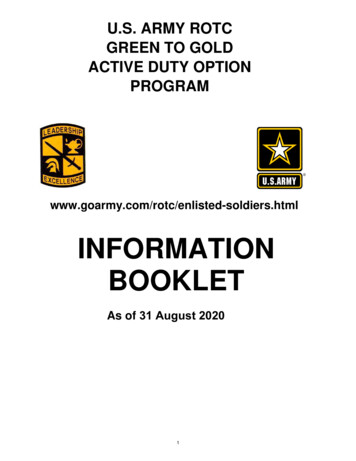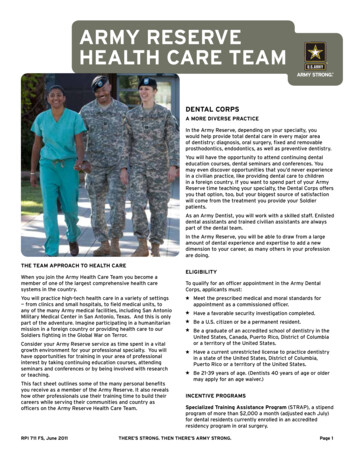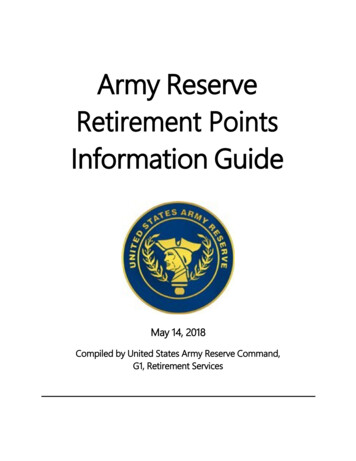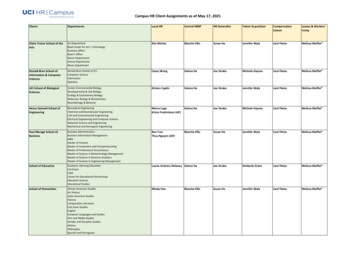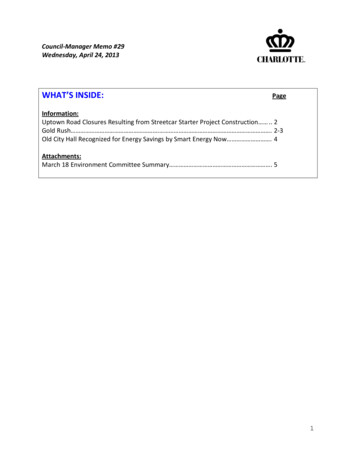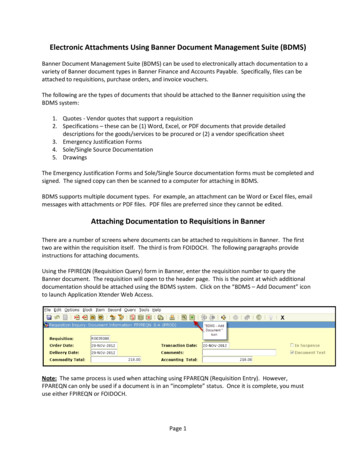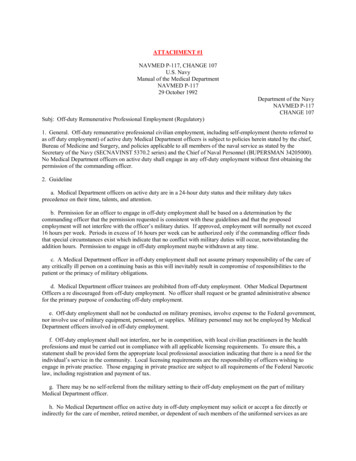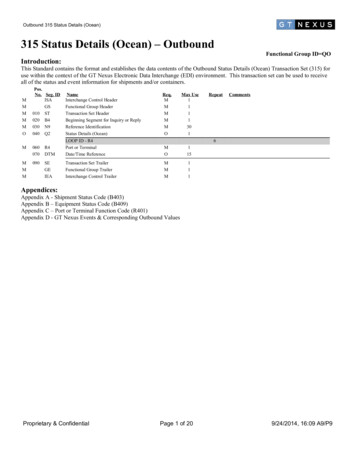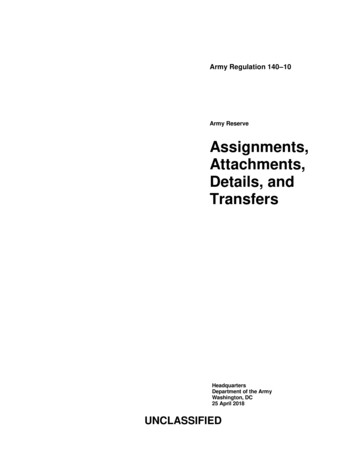
Transcription
Army Regulation 140–10Army ReserveAssignments,Attachments,Details, andTransfersHeadquartersDepartment of the ArmyWashington, DC25 April 2018UNCLASSIFIED
SUMMARY of CHANGEAR 140–10Assignments, Attachments, Details, and TransfersThis major revision, dated 25 April 2018—oStates that the Chief, Army Reserve may rescind authorities during periods of partial mobilization or higher based onoperational needs (para 1–4).oDeletes delegation of authority to a subordinate major United States Army Reserve Command and adds delegatingauthority to major subordinate commands/direct reporting command/general officer command level (para 1–4b).oIncorporates provisions of Department of Defense Instruction 1215.13, that defines reasonable commuting as thelongest a United States Army Reserve Soldier can be expected to travel involuntarily between their residence and asite where inactive duty training will be conducted based on Joint Travel Regulations (para 1–10).oAdds career management policy for U.S. Army Reserve officers and warrant officers (para 2–4).oClarifies elements of the Simultaneous Membership Program (para 2–13).oClarifies assignment limitations (para 2–17).oAdds overstrength personnel policy (para 2–18).oClarifies non-obligated officers’ assignment (para 2–22d).oAdds guidance for involuntary release of enlisted Soldiers (para 2–26).oClarifies the Officer Military Service Obligation (para 4–29l).oAdds authority for the Chief, Army Reserve to approve and delegate conditional release (para 5–1).oClarifies exceptions to removal from active status (numbered exceptions) (para 7–12).oRemoves exception number 1 (removal rule 2) and changes exception number 1.1 (removal rule 2.1) to read asexception number 1 (removal rule 2) (para 7–14).oAdds complete outline of the Standby Reserve (chap 8).oOutlines the Selective Retention Program; outlines Colonel and Lieutenant Command Assignment Selection Boardprocedures (chap 10).oSupersedes Army Directive 2016–29, Convening Authority for all U.S. Army Reserve Colonel and LieutenantColonel Command Boards (Army Promotion List and Army Medical Department) (chap 10).
HeadquartersDepartment of the ArmyWashington, DC25 April 2018*Army Regulation 140–10Effective 25 May 2018Army ReserveAssignments, Attachments, Details, and TransfersHistory.vision.This publication is a major re-Summary. This regulation covers policy and procedures for assigning, attaching,removing, and transferring U.S. Army Reserve Soldiers. It defines Ready ReserveControl Groups and the Selected Reserve.Detailed procedures are given for removingSoldiers from an active status. It also givesprocedures for inter-Service transfer and se- and forwarded through higher headquarterslective retention of unit Soldiers.to the policy proponent. Refer to AR 25–30for specific guidance.Applicability. This regulation appliesto the U.S. Army Reserve. It does not apply Army internal control process. Thisto Soldiers serving on active duty in the regulation contains internal control proviU.S. Army Reserve Active Guard Reserve sions in accordance with AR 11–2 andidentifies key internal controls that must beprogram.evaluated (see appendix B).Proponent and exception authority.The proponent of this regulation is the Dep- Supplementation. Supplementationuty Chief of Staff, G–1. The proponent has of this regulation and establishment of comthe authority to approve exceptions or mand and local forms are prohibited withwaivers to this regulation that are consistent out prior approval from Deputy Chief ofwith controlling law and regulations. The Staff, G–1, DAPE–ZA, 300 Army Pentaproponent may delegate this approval au- gon, Washington, DC 20310–0300.thority, in writing, to a division chief withSuggested improvements. Users arethe proponent agency or its direct reportinginvited to send comments and suggestedunit or field operating agency, in the gradeimprovements on DA Form 2028 (Recomof colonel or the civilian equivalent. Activmended Changes to Publications and Blankities may request a waiver to this regulationForms) directly to Deputy Chief of Staff,by providing justification that includes aG–1, DAPE–MP, 300 Army Pentagon,full analysis of the expected benefits andWashington, DC 20310–0300.must include formal review by the activity’s senior legal officer. All waiver re- Distribution. The publication is availaquests will be endorsed by the commander ble in electronic media only and is intendedor senior leader of the requesting activity for U.S. Army Reserve.Contents (Listed by paragraph and page number)Chapter 1Introduction, page 1Purpose 1–1, page 1References 1–2, page 1Explanation of abbreviations and terms 1–3, page 1Responsibilities 1–4, page 1Policy 1–5, page 2Orders 1–6, page 2Appointment as cadets at U.S. military academies 1–7, page 2Request for orders 1–8, page 2Unit training restriction 1–9, page 3Reasonable commuting 1–10, page 3Chapter 2Ready Reserve Assignments, page 3Section IThe Ready Reserve, page 3Ready Reserve 2–1, page 3*This regulation supersedes AR 140-10, dated 15 August 2005 and AD 2016-29.AR 140–10 25 April 2018UNCLASSIFIEDi
Contents—ContinuedStandby Reserve 2–2, page 3Retired Reserve 2–3, page 4Management of U.S. Army Reserve officers and warrant officers 2–4, page 4Section IISelected Reserve, page 5General 2–5, page 5Mandatory assignment 2–6, page 5Voluntary assignment 2–7, page 5Enlisted reassignments from the Individual Ready Reserve to a troop program unit 2–8, page 6Voluntary and involuntary reassignment between troop program units 2–9, page 7Dual status military technician assignments 2–10, page 7Assignment of officers to troop program unit position vacancies 2–11, page 7Request for DA Form 4935 2–12, page 7Simultaneous Membership Program 2–13, page 8Section IIIUnit Assignment Priorities, page 8Commissioned officer and warrant officer priorities 2–14, page 8Enlisted priorities 2–15, page 9Denied assignments 2–16, page 9Section IVUnit Assignment Policies, page 9Assignment limitations 2–17, page 9Overstrength 2–18, page 10Branch qualification on assumption of command 2–19, page 10Officer personnel assignments 2–20, page 10Branch/functional area—commissioned officers only 2–21, page 10Tenure 2–22, page 11Involuntary relief from drill sergeant duty 2–23, page 12Involuntary release of officers 2–24, page 12Enlisted personnel assignments 2–25, page 13Involuntary release of enlisted Soldiers 2–26, page 13Warrant officer candidate assignments 2–27, page 13Army aviator position assignments 2–28, page 14Chaplain position assignments 2–29, page 14Judge Advocate Assignments 2–30, page 14Section VArmy Medical Department Assignments, page 15Scope 2–31, page 15Army Medical Department positions 2–32, page 15Medical Service Corps positions 2–33, page 15Section VIAttachments, page 15General 2–34, page 15Troop program unit attachments 2–35, page 16Attachment guidance for Inactive Ready Reserve Soldiers and Standby Reserve (active status list) 2–36, page 16Attachment process 2–37, page 16Training attachments 2–38, page 17Orders 2–39, page 17Release from attachment for non-payment of Servicemembers’ Group Life Insurance premiums 2–40, page 17Chapter 3Branch Transfer, Branch Detail, and Change of Military Occupational Specialty, page 17iiAR 140–10 25 April 2018
Contents—ContinuedSection ITransfer between branches, page 17Branch transfer 3–1, page 17Approval authority for officer branch transfer and military occupational specialty reclassification 3–2, page 18Procedures 3–3, page 18Malassigned staff specialists 3–4, page 18Section IIDetail to Other Branches, page 19Branch detail 3–5, page 19Duty details and aides-de-camp detail 3–6, page 19Chapter 4Individual Ready Reserve, page 19Section IIntroduction, page 19General 4–1, page 19Composition of the Individual Ready Reserve 4–2, page 19Section IITransfer and Reassignment of Officers and Warrant Officers to the Individual Ready Reserve, page 20Scope 4–3, page 20Voluntary transfer or reassignment of troop program unit or individual mobilization augmentee officers and warrant officers 4–4, page 20Involuntary reassignment of troop program unit or individual mobilization augmentee officers and warrant officers 4–5, page 20Involuntary reassignment of troop program unit officers who have not completed officer basic course, or are assignedabove the maximum allowable strength limits, or are declared unsatisfactory participants 4–6, page 21Routine assignments to the Individual Ready Reserve 4–7, page 22Section IIITransfer and Reassignment of enlisted Soldiers to the Individual Ready Reserve, page 23Scope 4–8, page 23Policy governing the transfer or reassignment of troop program unit or individual mobilization augmentee enlisted Soldiers to the Individual Ready Reserve 4–9, page 23Voluntary reassignment of troop program unit or individual mobilization augmentee enlisted Soldiers 4–10, page 23Involuntary reassignment of troop program unit or individual mobilization augmentee enlisted Soldiers 4–11, page 23Routine assignment of enlisted Soldiers to the Individual Ready Reserve 4–12, page 24Voluntary reassignment of a surviving son or daughter 4–13, page 25Voluntary reassignment for dependency or hardship 4–14, page 25Voluntary reassignment for pregnancy 4–15, page 27Involuntary reassignment for unsatisfactory participation 4–16, page 27Involuntary reassignment for failure to maintain Army body fat standards 4–17, page 27Involuntary reassignment for inability to perform prescribed duties due to parenthood 4–18, page 27Involuntary reassignment after a review of a bar to reenlistment 4–19, page 28Involuntary reassignment because of overgrade 4–20, page 29Involuntary reassignment for failing to report to a troop program unit or individual mobilization augmentee assignment(No–Show) 4–21, page 29Transfer from control group (Delayed Entry Program) 4–22, page 29Transfer from control group (Reserve Officers’ Training Corp) 4–23, page 29Section IVReassignments within the Individual Ready Reserve, page 30Scope 4–24, page 30Reassignment between Individual Ready Reserve control groups 4–25, page 30AR 140–10 25 April 2018iii
Contents—ContinuedSection VTraining Individual Ready Reserve Soldiers, page 30Scope 4–26, page 30Training for mobilization 4–27, page 30Section VIRelease from Individual Ready Reserve Assignment, page 30Scope 4–28, page 30Release from Individual Ready Reserve Control Group Assignment 4–29, page 31Limitations on reassignment to a troop program unit or individual mobilization augmentee position based on the reasonsfor assignment to the Individual Ready Reserve 4–30, page 31Limitations on reassignment to a troop program unit or individual mobilization augmentee position based on an Individual Ready Reserve Soldier’s condition or status 4–31, page 32Chapter 5Transfer between the U.S. Army Reserve and Army National Guard, page 37Section ITransfer from the U.S. Army Reserve, page 37Conditional release 5–1, page 37Enlistment or appointment in Army National Guard 5–2, page 38Section IITransfer from the Army National Guard, page 38Reserve of the Army status 5–3, page 38Conditional release 5–4, page 38Procedures 5–5, page 38Orders 5–6, page 39Chapter 6Transfer to and from the Retired Reserve, page 39Section ITransfer to the Retired Reserve, page 39Eligibility 6–1, page 39Orders and certificates 6–2, page 39Ordering Retired Reserve members to active duty 6–3, page 39Section IITransfer from the Retired Reserve, page 40Criteria for transfer 6–4, page 40Application for transfer 6–5, page 40Soldiers determined indispensable 6–6, page 40Transfer orders 6–7, page 41Chapter 7Removal from Active Status, page 41Section IReasons for Removal, page 41General 7–1, page 41Length of service (removal rule 1) 7–2, page 41Maximum age (removal rule 2) 7–3, page 43Nonparticipation (removal rule 2.1) 7–4, page 43Failure to maintain a security clearance (removal rule 2.2) 7–5, page 43Non-selection for promotion (removal rules 3 and 4) 7–6, page 43Failure to complete military education requirements (removal rule 5) 7–7, page 44ivAR 140–10 25 April 2018
Contents—ContinuedNonacceptance of assignment (removal rule 6) 7–8, page 44Theological students failing to qualify for the Chaplain branch (removal rule 7) 7–9, page 44Miscellaneous reasons for removal (removal rules 8 through 18) 7–10, page 44Section IIExceptions to Removal from Active Status, page 45General 7–11, page 45Exception categories 7–12, page 45General exceptions 7–13, page 45Numbered exceptions 7–14, page 46Retention in an active status after failure to be selected for promotion (removal rules 3 and 4 and exception number2) 7–15, page 48Section IIIArmy Medical Department Officer Removal Exceptions and Processing Procedures, page 49General 7–16, page 49U.S. Army Reserve applicability 7–17, page 49Policy governing exceptions to removal for length of service or age 7–18, page 50Sequential extensions to removal rules 7–19, page 50Request procedures 7–20, page 50Reports 7–21, page 50Chapter 8The Standby Reserve, page 51Scope 8–1, page 51Active status list 8–2, page 51Inactive status list 8–3, page 52Screening of the Standby Reserve 8–4, page 52Chapter 9Inter-Service Transfer and Attachment, page 52Section ITransfer, page 52Inter-Service transfer 9–1, page 52Approval authority 9–2, page 53Applying for transfer 9–3, page 53Command processing 9–4, page 54Transfer from other Reserve Components 9–5, page 54Section IIAttachment, page 54Authorized attachment 9–6, page 54Request for attachment 9–7, page 55Attachment from other Reserve Components to U.S. Army Reserve units 9–8, page 55Chapter 10Boards, page 55Section ICommand Boards, page 55Scope 10–1, page 55Responsibilities 10–2, page 55Appointment of an acting commander 10–3, page 56Qualifications for command selection board consideration 10–4, page 56Command Selection boards 10–5, page 56Selections 10–6, page 57AR 140–10 25 April 2018v
Contents—ContinuedSection IISelective Retention Program, page 57Scope 10–7, page 57Purpose of selective retention proceedings 10–8, page 57Selective retention authority 10–9, page 58Responsibilities 10–10, page 58Selective Retention Boards 10–11, page 58Selections 10–12, page 58Officers subject to board consideration 10–13, page 59Officers not subject to board consideration 10–14, page 59Communication with the board 10–15, page 59Actions by convening authority regarding board recommendations 10–16, page 60Safeguard against premature removal 10–17, page 60Disposition of officers and warrant officers not selected for retention 10–18, page 60Board errors and omissions 10–19, page 60Section IIISelective Early Removal Boards, page 61Officers 10–20, page 61Responsible officials 10–21, page 61AppendixesA. References, page 67B. Internal Control Evaluation Checklist, page 72Table ListTable 4–1: Troop program unit and individual mobilization augmentee reassignment limitations based on the reason forassignment to the Individual Ready Reserve, page 33Table 7–2: Reasons for removal from active status, page 51Figure ListFigure 4–1: Sample notification of recommended involuntary individual ready reserve reassignment for inability to perform prescribed duties due to parenthood, page 35Figure 4–2: Sample of Soldier’s statement of acknowledgment regarding involuntary reassignment to the individualready reserve for inability to perform prescribed duties due to parenthood, page 37Figure 4–2: Sample of Soldier’s statement of acknowledgment regarding involuntary reassignment to the individualready reserve for inability to perform prescribed duties due to parenthood—Continued, page 37Figure 10–1: Sample notification of consideration memorandum, page 62Figure 10–2: Sample selection notification memorandum, page 63Figure 10–3: Sample of nonselection notification memorandum, page 64Figure 10–4: Format for board report, page 65Figure 10–5: Format for enclosure 2 (List Number 1) to the board report, page 66Figure 10–6: Format of enclosure 3 (List Number 2) to the board report, page 66GlossaryviAR 140–10 25 April 2018
Chapter 1Introduction1–1. PurposeThis regulation prescribes policies, responsibilities, and procedures to assign, attach, detail, remove, or transfer U.S. ArmyReserve (USAR) Soldiers.1–2. ReferencesSee appendix A.1–3. Explanation of abbreviations and termsSee the glossary.1–4. ResponsibilitiesOverall responsibilities are listed below. Specific responsibilities are given in each chapter. Based on statutory authority,the Chief, Army Reserve (CAR) may rescind the authorities identified in this regulation during periods of partial mobilization or higher or based on operational necessity. This notification will be done in writing with a copy provided to DeputyChief of Staff, G–1, (DCS, G–1). The provisions of this regulation are not applicable to Soldiers serving on active duty(AD) in the U.S. Army Reserve (USAR) Active Guard Reserve (AGR) program.a. The following may assign, attach, detail, or transfer Soldiers under their jurisdiction unless the authority is specifically restricted to Headquarters, Department of the Army (HQDA), DCS, G–1 and requires HQDA, DCS, G–1 approval:(1) HQDA, DCS, G–1.(a) Commanding General (CG), U.S. Army Human Resources Command (HRC).1. Approves all assignments to the Individual Mobilization Augmentee (IMA) Program.2. Manages the Individual Ready Reserve (IRR).3. Maintains the Army Military Human Resource Record (AMHRR) for all USAR Soldiers.(b) CG, U.S. Army Recruiting Command (USAREC).(2) Area commanders.b. Area commanders will—(1) Involuntarily reassign troop program unit (TPU) officers and warrant officers (WOs) to the appropriate IRR ControlGroup. This authority may not be delegated below General Officer Command (GOCOM) level and then only where thecommand is supported by a command or a staff judge advocate (SJA) office. The area commander and GOCOM commander may delegate this authority to their respective DCS, G–1, Human Resource Officer, or equivalent.(2) Reassign, attach, or detail a TPU officer, WO, or enlisted Soldier to a TPU in another area command with concurrence of the gaining area command.(3) Delegate reassignment, attachment, or detail authority to a major subordinate command (MSC), direct reportingcommand (DRC), and GOCOM, only where the command is supported by a SJA office.c. Where authority has been delegated, or otherwise provided by this regulation, MSC, DRC, or GOCOM commandersmay reassign or attach Soldiers under their command to—(1) Another MSC, DRC, or GOCOM within the jurisdiction of the area command and with the approval of the gainingGOCOM or between, commands subordinate to the MSC, DRC, or GOCOM.(2) The appropriate IRR Control Group.(3) The Retired Reserve.(4) The Standby Reserve (Active or Inactive list).d. A MSC, DRC, or GOCOM commander may further delegate authority to reassign or attach Soldiers to or betweencommands subordinate to the USAR Command (USARC) or the USAR GOCOM. Where delegated, a command authorized—(1) General officer commander may reassign or attach Soldiers to or between commands subordinate to the GOCOM.(2) Commander in the grade of colonel (COL) may reassign or attach Soldiers to or between commands subordinate tothe COL command.(3) Commander in the grade of lieutenant colonel (LTC) may reassign or attach Soldiers to or between TPUs subordinate to the LTC command.AR 140–10 25 April 20181
1–5. Policya. Personnel management policies will provide for equality of treatment and opportunity for all USAR Soldiers. Policywill be established without regard to race, color, national origin, religion, sex (including gender identity), and sexual orientation.b. Marital status of a Soldier or the employm
o Incorporates provisions of Department of Defense Instruction 1215.13, that defines reasonable commuting as the longest a United States Army Reserve Soldier can be expec
